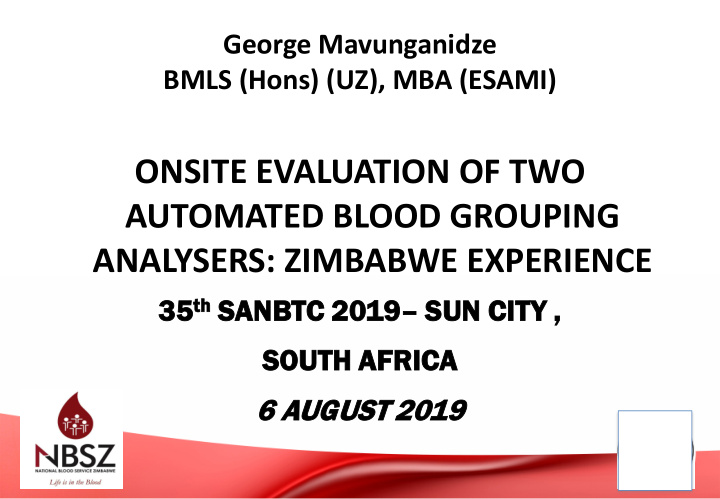



George Mavunganidze BMLS (Hons) (UZ), MBA (ESAMI) ONSITE EVALUATION OF TWO AUTOMATED BLOOD GROUPING ANALYSERS: ZIMBABWE EXPERIENCE th SAN 35 th ANBTC 2 C 2019 19– SUN C CITY , , SOUT UTH A AFRICA 6 AUGUST 2 2019
Presentation Format 1. Introduction & Background 2. Aims & Objectives 3. Study Design & Methods 4. Results 5. Conclusion 6. Recommendations 7. Acknowledgements
Introduction • RBC Immunohematology a key component for blood safety through donations testing. • ABO & RhD (Forward, Reverse); Ab Screening • AfSBT Accreditation standards requirement: Section B, Technical requirements 4.2.4: “Serum or plasma from donors shall be tested for unexpected red cell antibodies,….plasma from units with clinically significant Abs shall not be used for transfusion.” High titre allo-antibodies.
ZIMBABWE MAP
Background • NBSZ automated its donations blood grouping in 2011, (Tango Optimo, Bio-Rad). • Replacing the Conventional Test Tube (CTT) method which remained in use for confirmatory blood group testing. • The need for a robust/ higher throughput automated blood grouping system. Two systems evaluated • The JOURNEY – Kigali, AfSBT(2016), Cairo (2016), Tender (2017), Eval (Apr 1018) Go Live (April 2019)
Selection of the Blood Group Testing Systems
Aims and Objectives To evaluate the performance and efficiency of two fully automated immuno-hematological systems, and assess their role in donor blood group and antibody screening at NBSZ, with the intention of selecting one for routine use.
Study Design and Methods • Two automated analysers ( Qwalys 3 – erythro- magnetic technology) and ( NEO IRIS Solid phase red cell adherence) were compared with the Tango Optimo – Gold Standard . • Comparing: ABO & RhD typing and Ab Screening • Operational performance was assessed on throughput, loading options, reagent shelf life and instrument errors.
Sample Testing Sample Testing NEO IRIS QWALYS 3 ABO Blood Grouping 6012 6118 RhD Blood Grouping 6012 6118 Weak D Testing 198 22 Irregular Ab Screening 6167 6082 Irregular Ab Screening 12 N/A High ABO Antibody Titre 3453 N/A
Results -Summary Table 1: NEO Iris and Qwalys3 Results Tango NEO Iris Qwalys3 Optimo/CTT ABO Rhesus Weak D ABO Rhesus Weak D Concordance 99.5% 99.25% 99% 93.7% 93.3% * Discordance 0 0.03% 0.5% 0 0.4% * Uninterpretab le 0.5% 0.72% 0.5% 6.3% 6.3% * Total 100% 100% 100% 100% 100% *
Results,…Ctd • The NEO IRIS showed a concordance in results for 5982/6012 (99.5%) ABO and 5967/6012 (99.25%) RhD. There were 64/6012 (1.1%) samples with initially un-interpretable results. • The Qwalys 3 showed a concordance in results for 5734/6118 (93.7%) ABO and 5708/6118 (93.3%) RhD. 384/6118 (6.3%) were un-interpretable • 198 samples were tested for weak D on NEO IRIS whilst only 22 were tested on Qwalys 3 due to reagent outages/ expiries machine downtime.
User Experience Comparison Summary Technology/ Analyser NEO Iris Qwalys3 loaded samples at a time 176 144 STAT Function Present Not Present Throughput Less time for ABO Rh and antibody More time for ABO Rh and screen (135.1 min) antibody screen (153.4 min) Antibody Identification Yes No ABO Antibody Titration Yes No Test Run Flexibility Dynamic work flow Unable to change work flow pattern within run Assay order flexibility and reflex Ability to perform multiple tests on Only module testing possible: testing each sample -ABO/Rh and Ab Screen module Customize Reflex tests: Weak D & -Weak-D module antibody ID -Rhesus phenotyping module Liquid waste container Can be directly connected to the Emptied only possible by user sink or drain
Conclusion • Both analysers were easy to operate and are complete walk away with alarms systems for errors. • Based on: high concordance of ABO/RhD results, lesser un-interpretable results encountered, higher throughput & TAT and more flexibility in assay ordering and adjustment of workflow, the NEO IRIS was selected for routine use at NBSZ.
Recommendations 1. IMMUCOR’S high throughput, fully automated NEO IRIS can be used for routine, ABO, RhD & Ab Screening for maximum productivity 2. Onsite evaluation is the way to go before procurement especially for high cost Laboratory equipment.
Acknowledgements 1. National Blood Service Zimbabwe Management and Staff 2. IMMUCOR & HAEMOTEC (Qwalys 3) 3. SANBTC 2019 for the opportunity to share our experience
THANK YOU FOR YOUR ATTENTION gmavunganidze@nbsz.co.zw tonmav7@gmail.com +263 776 736 531 +263 712 634 333
Recommend
More recommend